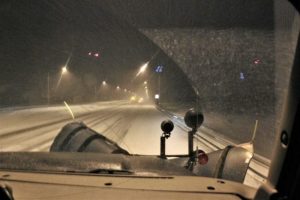
It’s winter, and that usually means plenty of snow and ice.
Every winter, many of us take it for granted that when we wake after a big snow fall, the roads will be clear and ready for the commute. But who do we have to thank for that?
I wanted to find out.
I arrived at the Department of Transportation’s maintenance bay off Glacier Highway at 4 a.m. Snow was falling and four huge trucks idled in the parking lot, ready to head out for the early shift.
I was about to live the dream of every truck-loving little kid. Before this assignment, my only experience with plow driving came courtesy of “The Simpsons.”
You know the jingle: “Call Mr. Plow, that’s my name. That name again is Mr. Plow!”
I’m sure the real thing isn’t as glamorous as Homer makes it seem. Still, with my snow boots and thermos full of hot chocolate, I may have been too excited.
“Do you get a lot of people asking for rides?” I asked Richard Asplund, the DOT plow driver who let me tag along.
“No, we don’t get a lot of requests,” Asplund said, laughing. “I have a daughter and no, there’s no way I’d bring her out here.”
I climbed into the front seat of Asplund’s truck and we set off into the early morning darkness. Egan Drive was almost empty as we fell into a diagonal formation with the other three trucks. Each plow picks up the snow leftover by the previous one, gradually pushing all of it onto the right shoulder in a flurry of white.
“The snow’s real light today, so as long as we’re not going too fast, we shouldn’t blast any mailboxes or garbage cans over,” Asplund said. “But if it’s wet snow and there’s a lot of it, it’s a real hazard.”
Ahead of us, graders worked the intersections clearing berms.
Asplund grew up on Prince of Wales Island. He came to Juneau two years ago from Petersburg. He got started as an equipment operator in the logging industry, but started working for DOT after the jobs dried up.
“So there’s really a lot going on at once,” I observed. “In addition to driving and watching where your other trucks are, you’re also operating the plow level with this joystick?”
“Yes, and the belly blade and the sander,” Asplund said. Coordinating all of those controls takes practice. Asplund said most crew members have worked around equipment for a long time. That helps.
The biggest hazard for drivers comes when regular drivers try to pass when they’re plowing in formation. The trucks are heavy to begin with and the extra winter equipment makes stopping quickly impossible.
At one point, a pickup started to pass us on the right with nowhere to go, since there were two more trucks ahead of us.
“It’s just more things I have to watch and be careful for,” Asplund said. “And he’s not gaining anything, you know. If he would just stay back he would be much better off.”
For plow drivers like Asplund, the day begins well before 4 a.m. Juneau’s plow team works holidays and weekends, depending on the schedule. Asplund said they rarely take vacation or sick days in the winter. They need to be ready to work whenever conditions call for it.
“Last year we worked 10 hour days,” Asplund said. “It just depends on how many people we have and how many shifts we have to cover.”
Drivers sometimes get called in on their days off in the event of a snowstorm that goes on for multiple days, Asplund said.
The rest of the year, Asplund is a foreman on DOT’s chip-sealing crew; he travels around the Southeast fixing roads.
“It’s always something different, you’re always learning something,” Asplund said. “There’s a lot of things I like about it.”
After a few hours, Asplund dropped me back at the garage and immediately headed back out. He continued plowing until noon, when the next shift took over.
Later on, I sat down with Southeast District Superintendent Scott Gray to get the bigger picture on plowing.
Just in the Southeast district, weather varies widely depending on where you are. Gray travels frequently to smaller communities where there may only be a small team covering miles of road.
“Haines and Skagway will get a lot more than we do. And then of course we have Hoonah and Gustavus that are kind of out there, and they get quite a bit of snow too,” Gray said. “And then in Sitka, we just had our first snow in Sitka on Jan. 9.”
Gray said he also fields complaints from the public, usually related to berms in driveways or occasional mailbox casualties. He said he would like to be able to take more people out in plow trucks to see what it’s like.
Now, when I’m shoveling the berm in front of my driveway or stuck behind a slow plow truck, I won’t feel the urge to shake my fist. Plowing isn’t an easy job, and I’m grateful that people like Asplund and Gray are out there making the roads safer for the rest of us.




